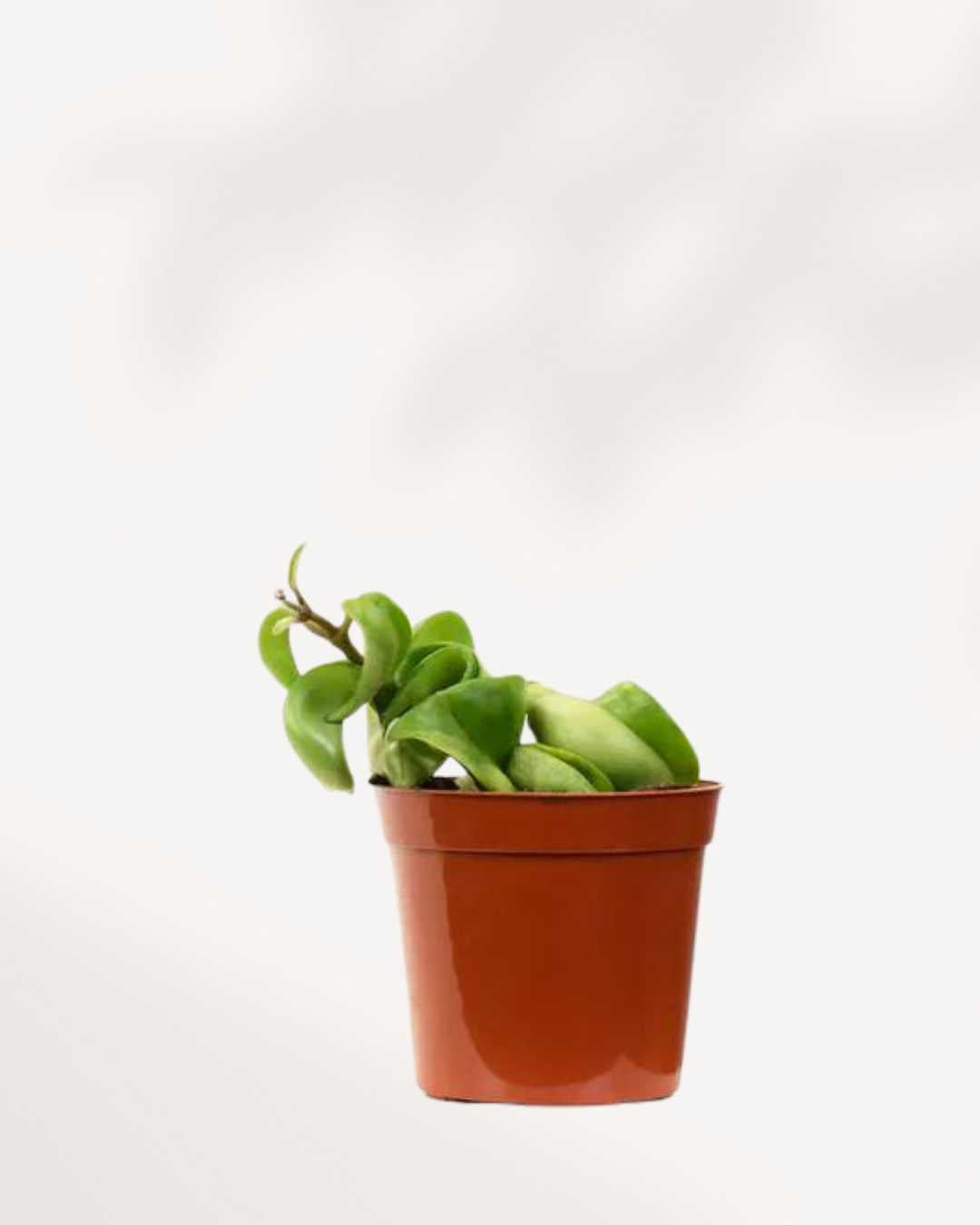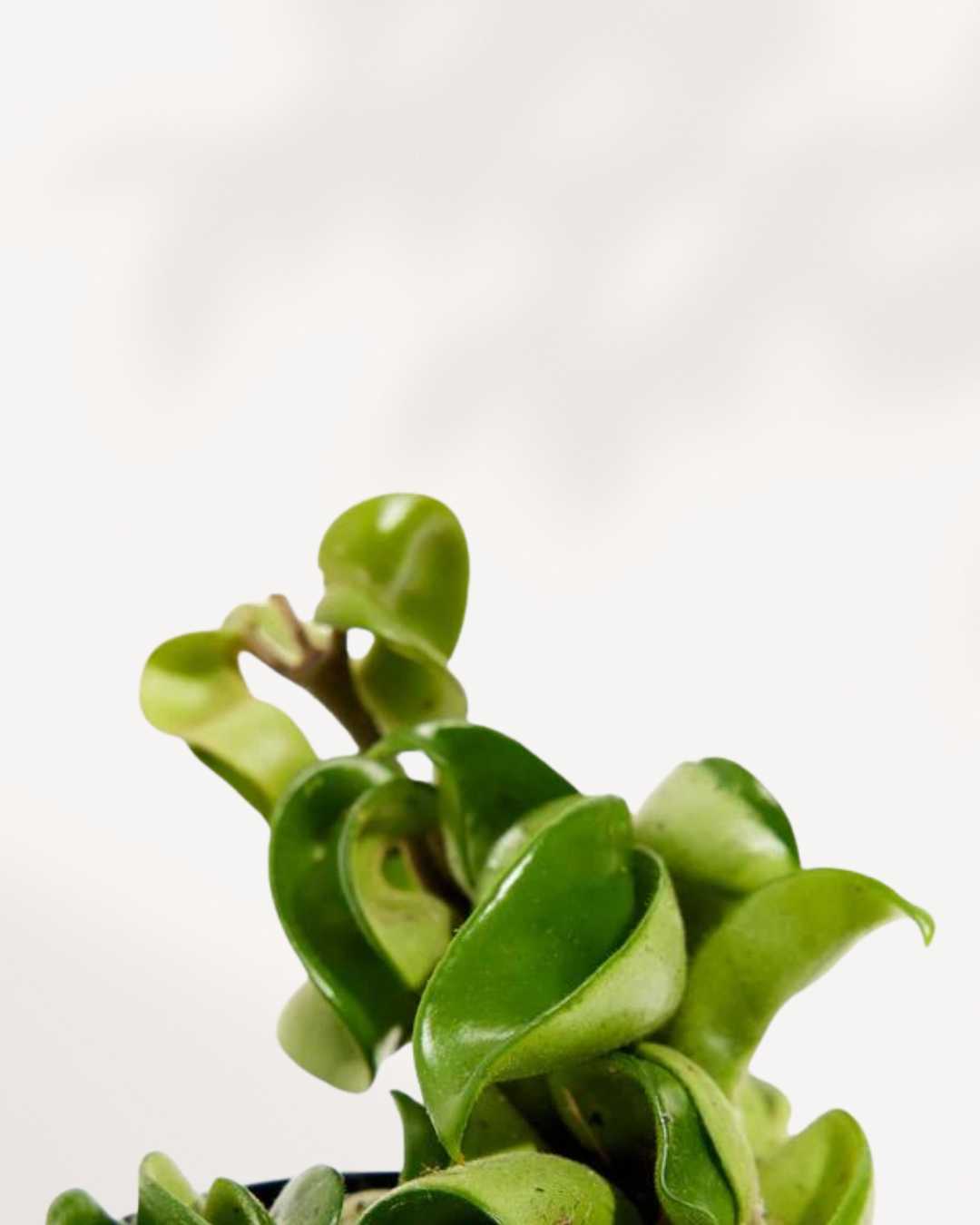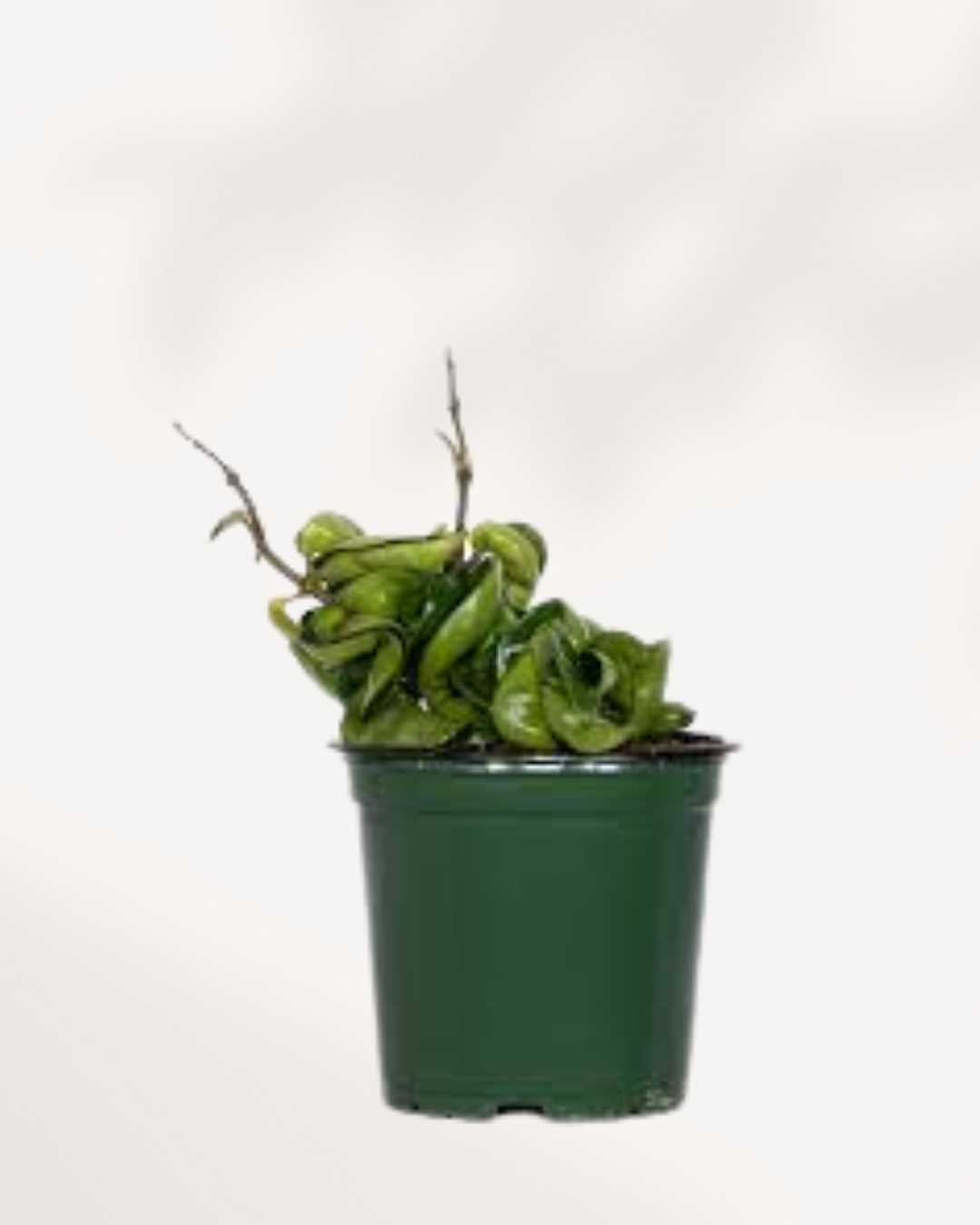Couldn't load pickup availability
Hoya Compacta 'Hindu Rope', commonly known as the "Hindu Rope Plant," is a unique and eye-catching variety of Hoya carnosa. It is admired for its thick, twisted, and curly leaves that resemble a rope. Native to Southeast Asia and Australia, this trailing or climbing vine is perfect for hanging baskets, shelves, or trellises. It is loved for its low-maintenance care and stunning clusters of star-shaped, fragrant flowers.
Common Names
- Hindu Rope Plant
- Wax Plant
- Rope Hoya
- Porcelain Flower
Botanical Classification
- Kingdom: Plantae
- Order: Gentianales
- Family: Apocynaceae
- Genus: Hoya
- Species: Hoya carnosa
- Variety: 'Compacta'
Description
Hoya Compacta 'Hindu Rope' is a slow-growing, evergreen vine known for its thick, curly, and waxy leaves that form dense, rope-like trails. Its unique foliage makes it highly decorative and ideal for cascading displays.
In addition to its attractive leaves, it produces clusters of star-shaped, pale pink flowers with red centers that emit a sweet fragrance, especially in the evenings. With proper care, this plant can reach up to 6 feet indoors.
Popular Hoya Varieties
- Hoya Krimson Queen – Variegated leaves with creamy-white edges.
- Hoya Macrophylla – Large, textured leaves with prominent veins.
- Hoya Carnosa Krimson Princess – Vibrant variegated foliage with pink highlights.
- Hoya Parasitica Black Margin – Compact, dark-edged leaves with a tropical appeal.
Care Guide
Light Requirements
Hoya Compacta 'Hindu Rope' thrives in bright, indirect light. It can tolerate lower light levels, but flowering may be reduced without sufficient light.
Watering Needs
Allow the top inch of soil to dry out between waterings. Avoid overwatering, as this can cause root rot. Reduce watering frequency during winter months.
Humidity
Prefers moderate to high humidity (50-70%). Regular misting or a humidifier can help maintain moisture, especially in dry environments.
Fertilization
Feed with a diluted, balanced liquid fertilizer every 4-6 weeks during the growing season. Avoid fertilizing during dormancy in winter.
Common Pests
Mealybugs: Treat with rubbing alcohol or insecticidal soap if infestations occur.
Spider Mites: Increase humidity and treat with neem oil or insecticidal soap.
Scale Insects: Remove manually and apply horticultural oil or insecticidal soap.
FAQs
How often should I water Hoya Compacta 'Hindu Rope'?
Water when the top inch of soil feels dry. Reduce watering during winter to prevent overwatering.
Is Hoya Compacta 'Hindu Rope' pet-friendly?
Hoya plants are generally non-toxic, but ingestion may cause mild digestive discomfort. Keep out of reach of pets as a precaution.
Does it need high humidity?
Yes, moderate to high humidity is recommended to support healthy growth and blooming.
Is it an air-purifying plant?
Yes, it helps improve indoor air quality. Explore more air-purifying plants.
How to take care of Hoya Hindu Rope
Sun: Indirect
Sun: Indirect
Light: Medium - Low
Light: Medium - Low
Water: When mostly dry
Water: When mostly dry
Humidity: Any
Humidity: Any
Pet Friendly: Yes
Pet Friendly: Yes
Pro Tip
Pro Tip
Delivery Policy for Plant Condition
Delivery Policy for Plant Condition
"I have only received part of my order. What to do?
No worries if you've only got part of your order! Our plants come from different nurseries and might arrive in separate shipments, typically 1-2 days apart. It's all part of ensuring your green friends reach you in top-notch condition!
If you do not receive the remaining packages within 48 hours contact support at info@mygreenscape.ca
What is the Life Time Support?
Absolutely! Lifetime support means you can count on us whenever you have questions or uncertainties about your plant. Whether you're puzzled by its behavior or just want to ensure it's thriving, we're here for you. Connect with us on Instagram @mygreenscapeto or shoot us an email at support@mygreenscape.ca.
When it comes to our guarantee for plants shipped with standard or express, rest assured that we offer a 30-day happy healthy plant guarantee on all such shipments. This ensures that your plants are covered for 30 days after delivery, giving you peace of mind regarding their condition. If you have any concerns within this period, feel free to reach out to us for assistance.
For further details, please visit our Local Delivery, Store Pickup, Standard Shipping Guide Page.
What to expect
What to expect
Your plant will arrive in a standard nursery pot, typically 0.5" - 1" smaller than the stated size to seamlessly fit into your chosen decorative pot. Washable Paper Planter Bags are available for separate purchase.
Just like nature intended, each plant is unique, showcasing natural variations in size, shape, and characteristics. Our commitment is to deliver a plant that closely resembles the one featured on our website, matching your chosen size, and with the potential to thrive happily in your home.
Frequently Asked Questions
Frequently Asked Questions
Certainly! If you're pondering about ordering plants online, you're not alone. We've compiled the most frequently asked questions. Check out our FAQ section here for quick answers! Happy planting!
Plant & Pot Size Chart
Plant & Pot Size Chart
Choosing the right pot size for your plants can be a daunting task, especially if you're new to gardening. But fear not! Our pot sizes chart can help you find the perfect match for your plants, ensuring they have enough space to grow and thrive. With our guide, you'll be able to confidently choose the right pot size and plant variety for your gardening needs.
Plant Pot Size Guide.

| Extra Small | 7-10 cm | 2.5 - 3 inches |
| Small | 11-12 cm | 3.5 - 4 inches |
| Medium | 14-17 cm | 5 - 6 inches |
| Large | 19-21 cm | 8 - 10 inches |
| Extra Large | 24-27 cm | 12 - 14 inches |
All sizes are specified in product details.
Your Complete Guide to Pot Sizes: What Size Should You Choose?

When selecting a pot for your plant, it's important to find the right size. But with all the different options out there, how do you know which one is best? We're here to help!
MyGreenscape's pot sizes chart is a great resource for finding your perfect fit. Our easy-to-read chart takes out all the guesswork and helps you quickly choose the right size for your plant.
Smaller pots are best for seedlings or small plants just starting out. These tend to be shallow but wide, allowing enough room for the roots of the young plant but not too much where they get overcrowded. Medium-sized pots are ideal when your plant has grown from its infancy and is ready for more space. These are deeper and wider than small pots, so that it can accommodate larger root systems - making sure your plant gets enough nourishment while still giving it breathing room. Large pots are top choice if you have an established plant in need of lots of space - think trees and large shrubs! The spacious depth and width allow plenty of room for deep root systems without struggling for air or light.
No matter what size you choose, MyGreenscape has got you covered, with our pot sizes chart guaranteeing you find the perfect fit every time!
Winter Shipping Protection
Winter Shipping Protection
We take extra care with each package during the colder months. For destinations experiencing cold weather, we provide insulated packaging and heat packs as needed to protect your plants from freezing temperatures. With Winter Shipping Protection, your plants are equipped to arrive safe and sound, even in winter’s chill.
Care Guide
Care Guide
Explore essential care tips. check out our Comprehensive Resource for Indoor Plant Care.



WATERING MADE EASY
Check soil moisture before watering and use a potting mix that drains well. It’s the secret to healthy, happy plants!
Hear From Happy Plant Parents.
Who have brought Mygreenscape plants into their homes.
















